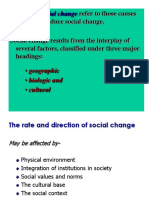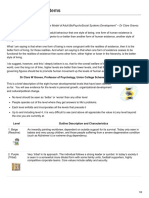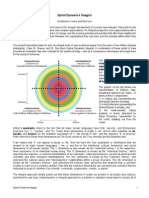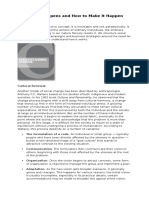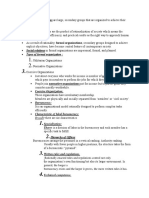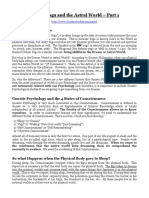Value system
A value system is the combined morals, ethics, standards, preferences, belief
systems and world views that define an individual, group or culture.[1] Socio-cultural
value systems[edit]
Developmental psychologist Clare W. Graves (1914-1986) first used the term value
system in his Emergent Cyclical Levels of Existence Theory. Practitioners of Graves' model
have defined value systems as a hierarchically-ordered, always open set of morals, ethics,
standards, preferences, belief systems and world views that come together through selforganizing principles to define an individual, a group or a culture. [2]
Graves' theory of human development posits that the psychology of the mature human
being transitions from a current level of cultural existence based on current life conditions to
a more complex level in response to (to cope with) changes in existential reality. Graves
used a double-helix model to illustrate a two-letter coding system that demonstrated the
relationship between the Problems of Existence (1st letter, starting at A) and Coping Tools
(2nd letter, starting at N). This model can also be interpreted to demonstrate the dual nature
of the spiral of human emergence and change states between communal/collective value
systems (sacrifice self) and individualistic (express self) value systems.
Through decades of experimentation and research, Graves classified a total of eight levels
of increasingly complex human sociocultural systems. He proposed that a value system
consists of a hierarchically ordered, always-open-to-change set of
identifiable ethics, morals, preferences, priorities, world views and purposes by which
groups and cultures structure their societies, and how individuals integrate within them.
Each of these levels of existence has its own distinct values that are particular to it,
developed as a response to solving the problems of the previous system. Alternating
systems exemplify either communal values (such as community, healthcare,
social welfare, social security, unions, justice and educational systems) or values that
gravitate toward the individual (self-expression, merit, innovation, achievement, exploration,
choice). Each system may express a healthy or unhealthy manifestation of its values, as
defined by Graves.
�Don Beck and Christopher Cowan developed the theory further and presented a structured
model of adaptive intelligence and sociocultural evolution in Spiral Dynamics: mastering
values, leadership and change (1996, 1999, 2005). The authors, who studied with Graves,
integrated Richard Dawkins' theory of memetics. Dawkins proposed an evolutionary model
of cultural information transfer in which ideas (memes) such as habits, beliefs, and patterns
of behavior proliferate, in a way similar to biological genes, through humans as they connect
with one another socially. This explains the systemic spread of values in society.
The Spiral Dynamics model demonstrates how value systems morph and spread as social
DNA in Graves' specific evolutionary sequence. The first six value systems (the First Tier
group) were color coded by Beck and Cowan (to facilitate training) as follows:
Level 1: Survival Instinct: Beige system (individualistic), origin 100,000 BCE
Level 2: Tribal/Kinship: Purple system (communal), origin 50,000 BCE
Level 3: Heroic/Empire: Red system (individualistic), origin 7,000 BCE
Level 4: Absolutist/Purposeful: Blue system (communal), origin 3,000 BCE
Level 5: Scientific/Strategic Enterprise: Orange system (individualistic), origin 1000600 CE
Level 6: Egalitarian/Communitarian: Green system (communal), origin 1850 CE
Graves grouped the First Tier systems by nature of their narrow perspective: each aligns
with a specific world view that rejects the prior systems and seeks to preserve its own status
quo. The differences between communal/collective and individualistic value systems, and
the inability of First Tier systems to recognize the strengths or pathologies of other world
views, helps to explain social conflict in the world today.
In addition, a world view exists in flux. Values may be
in transition between healthy and unhealthy states;
in a change state between systems (exiting one, entering another); or
may regress, become trapped, regain equilibrium, or grow following conflict.
Thus, an individual or culture may express the values of the system being exited as well as
the values of the emerging system; may have temporarily regressed to deal with conflict; or
may be arrested or transitioning within a specific world view in an unhealthy or healthy
state.
According to Graves, the move to Second Tier thinking requires a giant "leap" in
perspective. At Second Tier, society recognizes a responsibility for facilitating the health of
each value system on First Tier so that it can be self-actualized and healthy at its own level.
The goal is not expediting emergence but the result is, when healthy, each First Tier system
will naturally progress toward Second Tier. No step in human social evolution can be
skipped, according to Graves. Of late, we have begun to see what the Second Tier systems
will look like as Second Tier thinking emerges:
Level 7: Integrative/Systemic: Yellow system (individualistic), emerging now
Level 8: Holistic: Turquoise system (communal), conceptualized but not yet existing
this system cannot emerge until the life conditions in Yellow are realized. This system
will emerge in response to the problems arising within the Yellow system.
Published works have integrated the adaptive socio-cultural evolution model for over 30
years, including:
Dudley Lynch (1940-) produced, according to his website, "Several books on the
pioneering 'general systems' psychological developmental model of the late Clare W.
Graves, psychology's most original interdisciplinary explorer of how the mind grows",
including Strategy of the Dolphin: Scoring a Win in a Chaotic World(with Paul L. Kordis,
1989, William Morrow & Company), The Mother of All Minds: Leaping Free of an
Outdated Human Nature (2003, Brain Technologies Press), and LEAP! How to Think
Like a Dolphin & Do the Next Right, Smart Thing Come Hell or High Water (Brain
Technologies Press, 2012).
Integral theorist Ken Wilber (1949-) re-introduced Spiral Dynamics concepts in his
book A Theory of Everything (2000, Shambhala) where he attempts to bridge business,
�politics, science, spirituality and developmental theories, showing how they inter-relate
through his model of manifest existence.
Said E. Dawlabani introduced a value systems approach to macroeconomics in his
book [3] which includes a forward by Don Edward Beck. MEMEnomics reframes
economics (past, present and future) through a functional cyclical-emergent model,
including proscriptive advice through the lens of human socio-cultural value systems.
Based on his years of work with Beck, Dawlabani added a "spectrum of meaning"
concept which further defines values expressed in common ideas and terms through the
prism of the eight known value system levels. He also added a clarification to
the vMEME Attractor concept introduced in Beck and Cowan'sSpiral Dynamics. While
Beck & Cowan referred to larger modes through which cultures express their values,
such as religion, fashion, philosophy, etc.. as " vMEME-attractors",[4] Dawlabani rebranded these specialized meta-memes as General category Memes, or GMEMEs for
short, which gave continuity to the concept of memes as measurable values for large
scale applications such as the economics GMEME.[5]
Consistency[edit]
Further information: Consistency
As a member of a society, group, or community, an individual can simultaneously hold both
a personal and a communal value system. In this case, the two value systems (one
personal and one communal) are externally consistent provided they are no
contradictions or situational exceptions between them.
A value system is in its own right internally consistent when
its values do not contradict each other and
its exceptions are or could be
abstract enough to be used in all situations and
consistently applied.
Conversely, a value system by itself is internally inconsistent if:
its values contradict each other and
its exceptions are
highly situational and
inconsistently applied.
One of the conditions required for consistency in any logical (i.e. value-conserving) system
of statements is their transitivity. (See: Intransitivity#Occurrences in preferences.) Without it,
it might eventually happen that A is of greater value than B, yet B is of greater value than A
which is a case of mutual contradiction in certain statements that determine values
of A and B in the system. Value system consistency can be a value in and of itself.
Value exceptions[edit]
Abstract exceptions serve to reinforce the ranking of values. Their definitions are
generalized enough to be relevant to any and all situations. Situationalexceptions, on the
other hand, are ad hoc and pertain only to specific situations. The presence of a type of
exception determines one of two more kinds of value systems:
An idealized value system is a listing of values that lacks exceptions. It is, therefore,
absolute and can be codified as a strict set of proscriptions on behavior. Those who hold
to their idealized value system and claim no exceptions (other than the default) are
called absolutists.
A realized value system contains exceptions to resolve contradictions between
values in practical circumstances. This type is what people tend to use in daily life.
The difference between these two types of systems can be seen when people state that
they hold one value system yet in practice deviate from it, thus holding a different value
system. For example, a religion lists an absolute set of values while the practice of that
religion may include exceptions.
Implicit exceptions bring about a third type of value system, called a formal value system.
Whether idealized or realized, this type contains an implicit exception associated with each
value, and these exceptions are such that no value violates a higher-priority value. For
�instance, a person might feel that lying is wrong, and yet consider lying to save someone's
life as morally acceptable, with the reason being that the person holds preserving a life as a
higher-priority than avoiding lying. Perhaps too simplistic in practice, such a hierarchical
structure may warrant explicit exceptions.
Conflict[edit]
It might be that, despite sharing a set of common values, different parties do not rank those
values equally; such as hockey is better than baseball, or ice cream is better than fruit. Also,
two parties might disagree as to whether certain actions are right or wrong, both in theory
and in practice, and find themselves in an ideologicalor physical conflict. Ethonomics, the
discipline of rigorously examining and comparing value systems, enables us to
understand politics and motivations more fully in order to resolve conflicts.
An example conflict would be a value system based on individualism pitted against a value
system based on collectivism. A rational value system organized to resolve the conflict
between two such value systems might take the form below. Note that added exceptions
can often become recursive and convoluted.
Individuals may act freely unless their actions harm others or interfere with others'
freedom or with functions of society that individuals need, provided those functions do
not themselves interfere with these prescribed individual rights and were agreed to by a
majority of the individuals.
A society (or more specifically the system of order that enables the workings of a
society) exists for the purpose of benefiting the lives of the individuals who are
members of that society. The functions of a society in providing such benefits would be
those agreed to by the majority of individuals in the society.
A society may require contributions from its members in order for them to benefit
from the services provided by the society. The failure of individuals to make such
required contributions could be considered a reason to deny those benefits to them,
although a society could elect to consider hardship situations in determining how much
should be contributed.
A society may not restrict behavior of individuals who are members of the society,
except when those restrictions are necessary to allow society to perform those functions
designated to it by the majority of individuals in the society or when the behavior being
restricted violates the aforementioned values. This means that a society may abrogate
the rights of any of its members who fail to uphold the aforementioned values.
Corporate value systems[edit]
Fred Wenstp and Arild Myrmel[6] have proposed a structure for corporate value systems
that consists of three value categories. These are considered complementary and
juxtaposed on the same level if illustrated graphically, for instance on an organization's web
page. The first value category is Core Values, which prescribe the attitude and character of
an organization. These values are often found in sections regarding code of conduct on an
organization's web page. The philosophical antecedent of these values is virtue ethics,
which is often attributed to Aristotle.
The second value category is Protected Values, which are protected through rules,
standards, and certifications. They are often concerned with areas such as health,
environment, and safety. The third value category, Created Values, comprises the values
that stakeholders, including the shareholders, expect in return for their contributions to the
firm. These values are subject to trade-off by decision-makers or bargaining processes. This
process is explained further in stakeholder theory.
See also[edit]
Actor analysis
Applied ethics
Intrinsic value (ethics)
Moral code
Morality
Moral values
Value judgment
Value pluralism
Values
Spiral Dynamics
Social value orientations
Memetics
References[edit]
1.
Jump up^ "The Psychosocial DNA of Capitalism". Huffington Post. 2013.
2.
Jump up^ "The Psychosocial DNA of Capitalism". Huffington Post. 2013.
3.
Jump up^ MEMEnomics; the Next-Generation Economic System (2013,
SelectBooks)
4.
Jump up^ Beck, Don (2003). Spiral Dynamics, Mastering Values, Leadership,
and Change. Malden, MA: Blackwell Publishing. p. 31. ISBN 155786-940-5.
5.
Jump up^ Dawlabani, Said (2013). MEMEnomics, The Next-Generation
Economic System. New York, NY: SelectBooks, Inc. p. 38. ISBN 978-1-59079-996-3.
6.
Jump up^ Wenstp, F. and A. Myrmel (2006). "Structuring organizational value
statements " Management Research News 29(11
value system
A coherent set of values adopted and/or evolved by a person, organization, or society as a standard to guide
its behavior in preferences in all situations.
Read more: http://www.businessdictionary.com/definition/value-system.html#ixzz3NwejDWVp
Noun 1. value-system - the principles of right and wrong that are accepted by an individual or a
social group; "the Puritan ethic"; "a person with old-fashioned values"
ethic, moral principle, value orientation
�principle - a rule or standard especially of good behavior; "a man of principle"; "he
will not violate his principles"
Chartism - the principles of a body of 19th century English reformers who advocated
better social and economic conditions for working people
Based on WordNet 3.0, Farlex clipart collection. 2003-2012 Princeton University, Farlex Inc.
�Chapter 1: Relationships are based on common
value systems
Your value system is the sum total of your ideas and beliefs. It
includes every opinion you hold about life. Each thing you like or
dislike, and the importance each one has to you, merges to form your
unique value system.
Your value system develops through what you are taught and
experience, combined with your reactions to them, forming your
preferences and your unique perspective on life. Ultimately, every
opinion you have in life is based on something in your value system.
No two people completely share the same value system because our
values are more than our moral beliefs. They are also shaped by our
preferences for kinds of food, our hobbies, and types of
entertainment. Not everything in a person's value system is a matter
of right or wrong. Some of what we like or dislike is absolutely nonmoral.
We can develop relationships around non-moral values, such as our
hobbies and entertainment. However, in order to have strong
relationships with others, we need to have certain values in common.
Most significantly, our moral values must be as similar as possible.
The quality of any relationship is directly linked to the importance of
the shared values. Two people may share a common interest in
football, but if one thinks the other is a liar and a thief, they likely will
not develop a deep friendship. On the other hand, if we have a
mutual interest in keeping our neighborhood safe, our views on
sports will not interfere with our working together for that common
goal.
�Relationships grow over time as the participants grow together in
their values. When two people meet for the first time, they do not
know very much about what the other person values. Each one makes
assumptions about the other, some of which are true while others are
false. Yet, over time, if they discover that they agree on their most
important values, their relationship will deepen and grow stronger.
This is also true regarding all family relationships. Parents usually
seek to instill their values into their children. As a child grows, she
forms her own unique value system. She either rejects or retains her
parents values, and she chooses how much influence each value will
have in her own life. The quality of the relationship the parent and
child share is completely dependent on how much they agree on each
other's most significant values.
Relationships are based on common values systems and you
experience this truth every day. You want to be with those who share
your interests and moral ideas. Conversely, you avoid people who do
not share values similar to yours, whether in moral areas of life or
simply in manners or interests. In fact, it is difficult to enjoy a
relationship with someone who is substantially different from you.
Of course, the true values that we hold are the ones by which we
actually live. If we claim to value something, yet do the opposite of it,
then we actually value something else. If I claim to value truth, yet
lie, then there is something more important to me than telling the
truth. My lies prove that I hold some other value more deeply than
honesty.
Every family has rules or expectations of what each member should
or should not do. The degree to which we follow those expectations
reveals how much we agree with them. Although we might not agree
on a rule or expectation, we might still live according to it in order to
preserve our family relationships. In that case, we value the
relationship as more important than choosing our own rules and
having our own way.
�Our actions are the first indicators to ourselves and others about the
values we hold because the values that we live by are connected to
what is most important to us. However, we can sometimes have other
desires in our hearts that differ from our actions. To be completely at
peace within yourself, there must be conformity between your
deepest values and how you actually live. That is, you must be
committed to your deepest values and seek to live according to them.
Otherwise, you will experience inner conflict because you have not
determined which values are most important to you, and every choice
you make will not flow from a firmly held belief about that area of
life.
This inner conflict is sometimes revealed through your emotions.
When you struggle in making an important decision, it might be
because you do not have a firm value about it, or because you lack the
information you need to match it to the values you hold. From
strongly held values comes a greater ability to make choices in life.
Experiencing emotion that you enjoy (such as happiness) is an
indication that you are obtaining what you value. Getting what you
want and having things done your way results in satisfaction and
pleasure. Emotions reveal your values. The stronger you feel an
emotional response, the more important the value is to you that is
being fulfilled.
Although any fulfillment of our values can feel good, our greatest
happiness comes from experiencing positive emotions that fulfill our
values in the context of relationship. Relationships that make us
happy are based on common values and are enjoyable, satisfying, and
fulfilling. To experience them, we need to understand ourselves and
connect deeply with one another.
Chapter 2: All conflict in relationship is conflict
over value system
�Whenever you experience a disagreement with someone, it is always
a disagreement over one of your values. That is, you see the matter
one way, and the other person sees it another way. It may be
something trivial or something extremely important to you, but all
conflict in relationship is conflict over value system.
That which we agree on draws us closer together, whereas
disagreement drives us apart. The more important something is to
you--the more you value it--the greater the conflict you will have
when someone disagrees with you or obstructs your plans. This
conflict over value system is the destructive factor in all relationships.
When a person first feels in love, one aspect of the emotion flows
from strong beliefs about the other person's value system. We tend to
believe that the other person values the same things we do. However,
as the relationship progresses, we begin to realize that we do not
share all the values we first anticipated. It is during these times of
disappointment or conflict that we discover the real values of one
another. As the illusion of common values breaks down, so do some
of the positive emotions.
Although we want our relationships only to produce happiness, we
know that they do not. Conflict in relationship produces fear that we
will be rejected because of our values. Therefore, we begin to hide our
true desires from others, which produces feelings of loneliness even
in the midst of relationship.
We often desire to freely express who we really are to another
person--even if only one other person. The expression of who we are
is a full revelation of our deepest values. Not only do we want to be
open and honest about who we are and what we desire, we also want
to be accepted as we are. Although we know there are parts of us that
need improvement, we do not want to be criticized as we seek to
change our lives to match our highest virtues. We imagine the perfect
relationship to be one where we can openly share the deepest desires
of our hearts and yet never experience rejection for what we are.
�Conflict in relationship is conflict over value system and we
experience it frequently. Every quarrel or fight is a battle over whose
value will prevail. It may be as trivial as deciding which movie to
watch, or as severe as quitting your job because your boss treats you
badly.
You even experience conflict with those you love whenever their
desires do not match yours. As long as you both agree, you do not
have conflict because you are living a shared value system. But each
time you disagree, the magnitude of the dispute is related to how
important the current issue is to you. The level of conflict is directly
proportional to the significance each of you place on the value over
which you disagree.
Experiencing emotions that you do not enjoy (such as sadness or
anger) is an indication that your values are not being fulfilled. You
feel negative emotion when you are not getting what you want and
are not having things done your way. When people or situations do
not meet your expectations, you experience your values as an
expression of your emotions. The stronger you sense these negative
feelings, the more significant the values underlying them are to you.
It is important to note that emotions are only a response to whether
or not your values are being accomplished. Many people attempt to
stop being angry without understanding and dealing with its source:
the value conflict between them and another person. Until the real
issue is dealt with, feelings of anger will not be kept in check.
When you prolong conflict in relationship, it demonstrates that what
you value is more important to you than the relationship. You would
rather have your own way than have the relationship progress and
improve; and, if you cannot have your own way, then you are willing
to let the relationship degrade. People argue because they have
different values from each other, and unless they view the
relationship as more important than the subject of conflict, they will
�be more willing to dissolve it rather than resolve their differences in
value system.
For example, couples often disagree about money and how it should
be earned, spent, or saved. Each idea they have flows from something
deep within. It may be because they want the pleasure of spending it
or the security of saving it. Therefore, when a couple disagrees about
money, they need to be able to understand and express the values
driving their desires and feelings. If they cannot come to an
agreement on values, they need to at least agree that their
relationship is more important to them than their choice in how to
spend money. Hopefully, from the greater value they place on
relationship will come the means by which to resolve their lesser
values concerning money.
If we truly desire to have good relationships, we need to resolve
conflicts by changing our values. Some of your values will need to
change as well as some of the other person's. We will not agree on
how important everything in life is, but to grow closer we must agree
on the values we deem most significant.
We must also feel acceptance when we express our values. If we
cannot share the deepest values of our hearts and still be accepted,
then the relationship will never bring us the fulfillment we desire. We
will continue to have conflict with each other because, without
openness, we will not understand the values that are really producing
the conflict.
Lying is destructive to relationship because lying is pretending to
share a common value system without actually agreeing on it. It
wants the benefits of relationship without truly sharing the values
that produce relationship. People often lie in order to prevent
conflict, but they only produce more once their dishonesty and
hypocrisy are discovered.
�Good relationships can only be formed by sharing your true values.
To be accepted and liked for values that you are only pretending to
possess is not real relationship, and it will never bring deep
fulfillment. If values you hold are interfering with your relationships,
you need to choose whether you would rather improve your
relationships or keep your current values.
Noun[edit]
value system (plural value systems)
1. A hierarchy of values that all moral agents possess, demonstrated by their choices.
Most people's value systems differ, making the imposition of a singular value system
by the state a source of constant social warfare. This is an individualistic concept.
One's value system is molded by one's virtues or vices.
2. A person's standards and self-discipline set, based on the common
sense and wisdom of knowing what the proper moral rules and discipline are, and
the amount of willingness to see themselves and others abide by them.











